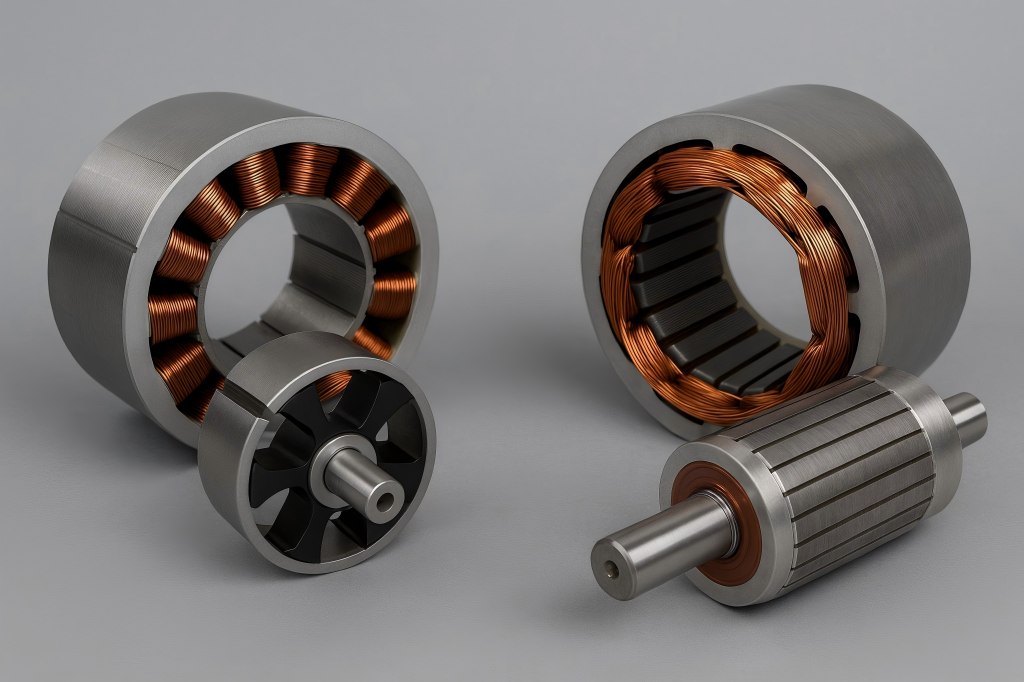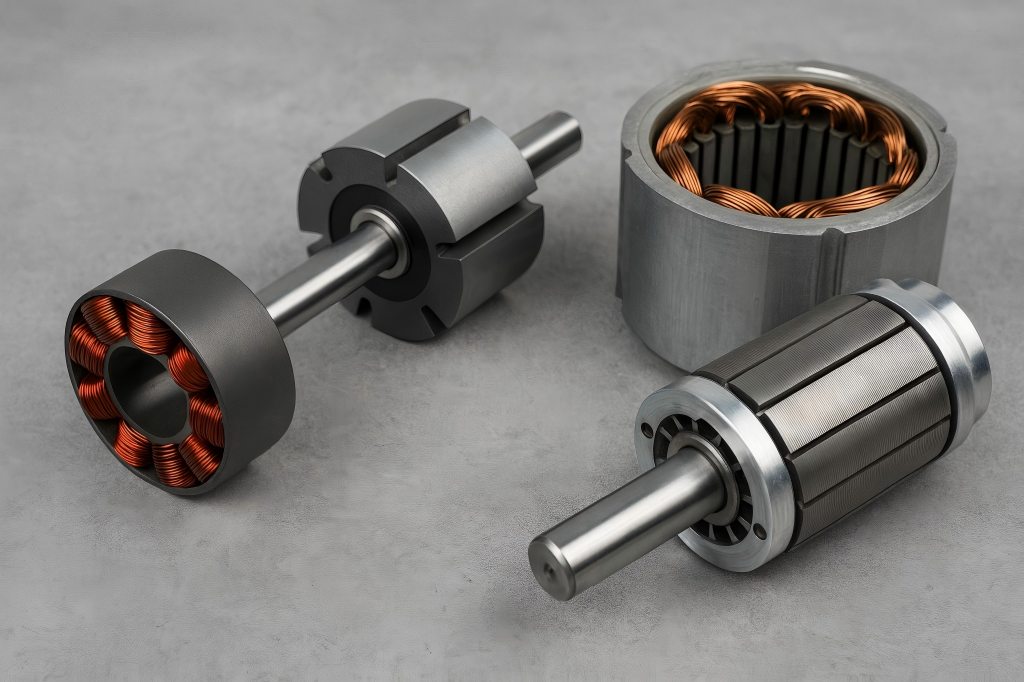As industries aim to save energy, electric motors are crucial for cutting power use and supporting sustainability. Their performance relies on two key parts: the stator and rotor. With stricter energy rules, the main question is—which motor, BLDC or induction, is more efficient?
BLDC Motor Stator and Rotor
The BLDC motor, a type of synchronous motor, operates using permanent magnets on the rotor and electronically controlled commutation on the stator. It is widely celebrated for its high power density, excellent speed-torque characteristics, and overall system efficiency.
Stator Design
The stator in a BLDC motor is constructed using laminated steel cores embedded with copper windings. These windings are arranged in a three-phase configuration and are energized sequentially by a controller. Instead of relying on mechanical brushes and commutators, the BLDC motor uses either Hall sensors or sensorless techniques to determine the rotor position and apply the correct current phase.
- Core Material: Usually composed of low-hysteresis loss, premium silicon steel laminations.
- Winding Type: Can be distributed or concentrated, often customized to optimize torque production and reduce cogging.
- Back EMF Profile: Commonly trapezoidal or sinusoidal, influencing control complexity and smoothness.
Rotor Design
The rotor is built with rare-earth permanent magnets—commonly neodymium (NdFeB)—arranged on or within a rotor core. These magnets maintain constant magnetic fields, eliminating the need for rotor excitation current and thus significantly reducing power losses.
- Rotor Topologies: Includes surface-mounted, interior permanent magnet (IPM), and spoke-type designs.
- Material: For structural integrity, stainless steel or other non-magnetic materials are frequently used to make the rotor shaft and core.
Torque is produced when the rotor’s permanent magnetic field engages with the stator’s electromagnetic field, with exact current switching ensuring tight control.
Induction Motor Stator and Rotor
Induction motors, particularly squirrel-cage types, dominate in industrial settings due to their ruggedness, simplicity, and low cost. Unlike BLDC motors, they do not have permanent magnets or rotor windings that need an electrical connection.
Stator Construction
The stator of an induction motor also uses laminated silicon steel cores with embedded windings. When connected to an AC power supply, these windings produce a rotating magnetic field.
- Winding Configuration: Three-phase distributed winding is standard, enabling smooth sinusoidal magnetic fields.
- Core Laminations: Thicker laminations than BLDC stators, leading to higher core loss at high frequencies.
- Slot Design: More slots are used to reduce harmonic distortion and improve torque ripple characteristics.
Rotor Construction
The rotor is typically a cast aluminum (or copper) squirrel cage—solid conductive bars short-circuited by end rings. These conductors generate current when the stator’s spinning magnetic field passes by them. This current then generates a magnetic field of its own, which combines with the stator field to generate motion.
- Slip Principle: The rotor must rotate at a slower speed than the stator field to induce current, a key difference from BLDC synchronous operation.
- Material Considerations: Copper rotors are more efficient but costlier than aluminum.
This induced operation leads to higher internal power losses, but also simplifies the construction and maintenance of the motor.
Efficiency Metrics
After accounting for all types of loss, the efficiency of electric motors is determined by evaluating how well electrical energy is transformed into mechanical energy.
BLDC Motor Efficiency Metrics
- Typical Efficiency: 85% to 95%, depending on speed, load, and control strategy.
- Copper Losses: Occur in stator windings; minimized through optimized wire gauge and cooling.
- No Rotor Copper Losses: Since magnets are used, rotor I²R losses are eliminated.
- Core Losses: Lower due to thinner lamination and high switching frequency.
- Torque Ripple: Controlled through waveform shaping and sensorless control algorithms.
Induction Motor Efficiency Metrics
- Typical Efficiency: 75% to 90%, usually optimal near rated load.
- Rotor Copper Losses: Account for significant power loss due to induced current.
- Stator Copper and Core Losses: Higher at light loads and low frequencies.
- Friction and Windage Losses: Slightly higher due to mechanical construction.
- Slip Loss: A continuous power drain during operation that does not exist in BLDC motors.
When comparing the two, BLDC motors show higher peak efficiency and better performance under partial load and variable-speed conditions.
Thermal Management and Cooling Requirements
Thermal performance directly affects a motor’s ability to sustain efficiency over time.
BLDC Motor Thermal Dynamics
- Stator-Centric Heating: Most of the heat is generated in the stator, where active cooling (air or liquid) is more easily implemented.
- Rotor Remains Cool: Permanent magnets generate negligible heat, enhancing thermal reliability.
- Thermal Sensors: Often integrated with controllers for precise thermal feedback.
Induction Motor Thermal Dynamics
- Distributed Heating: Both stator and rotor produce heat, with the rotor often harder to cool due to rotation.
- Rotor Overheating Risk: Induced current can lead to thermal degradation of end rings or conductor bars.
- Cooling Techniques: Heavily rely on external fans or closed-loop cooling in large motors.
BLDC motors enjoy a thermal advantage, particularly in compact or sealed applications where heat dissipation is challenging.
Control Strategy Impact on Efficiency
Motor control strategies not only regulate performance but also play a crucial role in energy consumption.
BLDC Motor Control Systems
- Electronic Commutation: Replaces mechanical commutation for precise control.
- Sensorless vs. Sensored Control: Sensorless designs reduce hardware cost but require advanced algorithms.
- Enhanced Modulation: Direct Torque Control (DTC) and Field-Oriented Control (FOC) maximize dynamic response and reduce losses.
Induction Motor Control Systems
- VFDs (Variable Frequency Drives): Modulate voltage and frequency to improve part-load efficiency.
- Scalar Control (V/f): Simple and cost-effective but less efficient at variable loads.
- Sensorless Vector Control: Offers better torque control but introduces harmonic losses.
BLDC motors, with their digital controls and regenerative braking, achieve higher overall control-based efficiency—especially in modern applications requiring frequent speed changes.

Application-Specific Performance
Electric Vehicles (EVs)
- BLDC Advantages: High torque at low speeds, compact size, regenerative braking.
- Induction Use: Historically used by Tesla, now largely replaced by permanent magnet motors for efficiency.
Industrial Automation
- Induction Motors: Preferred for conveyor belts, pumps, and compressors due to ruggedness and simplicity.
- BLDC Motors: Increasingly used in robotic arms, CNC machines, and servo systems requiring precise control.
Consumer Appliances
- BLDC Motors: Found in washing machines, fans, and HVAC systems for energy savings and quieter operation.
- Induction Motors: Still common in legacy systems due to low cost and long service life.
Renewable Energy Systems
- BLDC Motors: Used in small-scale wind and hydro systems.
- Induction Motors: Used in large, grid-tied wind turbines with external inverters.
Manufacturing Complexity and Cost Considerations
BLDC Motor Manufacturing
- Magnet Integration: Handling rare-earth magnets requires precision and thermal protection.
- Controller Integration: Adds to system cost but offers programmable flexibility.
- Customization: High, especially in stator winding topology and rotor shape.
Induction Motor Manufacturing
- Mass Production Friendly: Simple, standardized components allow cost-effective production.
- Die-Cast Rotors: Aluminum casting reduces labor and machining needs.
- Lower Electronics Requirement: Drives and controllers are optional for fixed-speed setups.
Despite BLDC motors being more efficient, their initial production cost is higher due to materials and electronics. However, long-term energy savings might balance this out.
Lifecycle Efficiency and Maintenance
BLDC Motor Lifecycle
- Longer Operational Life: No brushes to wear out, fewer mechanical contacts.
- Low Maintenance: Perfect for sealed or difficult-to-reach systems.
- Predictive Monitoring: Controller feedback allows for preventive diagnostics.
Induction Motor Lifecycle
- Mechanical Durability: Proven over decades of use, especially in industrial environments.
- Requires Maintenance: Bearings, fans, and insulation degrade over time.
- Easy to Rewind and Repair: Lower repair cost in case of failure.
When total cost of ownership and maintenance downtime are factored in, BLDC motors frequently deliver better lifecycle efficiency—especially in systems with frequent start/stop cycles.



